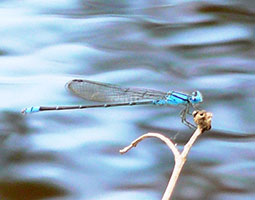Ischnura heterosticta
Description

The Common Bluetail Damselfly, found throughout the entire continent of Australia, is generally found near slow-running or still water. Most males have blue eyes, a blue and black thorax, black abdomen with a blue ringed tail. The females have a variety of forms including green, brown, black and a form with very similar colourings to the male.
Damselflies belong to the order Odonata (which also includes dragonflies). The eggs are laid in or near fresh water, and hatch into nymphs which moult repeatedly. At the last moult, they climb out of the water to undergo metamorphosis (changes that occur from the nymph to adult stage). The skin splits down the back, they emerge and inflate their wings and abdomen to gain their adult form.
When Common Bluetail Damselflies are at rest, they hold their wings closely folded up vertically over their thorax, whereas dragonflies generally hold theirs spread out.
Adaptations
- Nymphs can change colour during their development to camouflage with surrounding vegetation or even to discourage some predators
- Nymphs possess a large lip or jaw that can extend to entrap small aquatic invertebrates
- Adults possess four individually controlled wings that allow it to turn quickly in any direction while in flight to catch prey or avoid capture
Feeding relationships
- What I eat: nymphs eat small aquatic invertebrates, tadpoles and occasionally small fish; adults eat other flying insects
- What eats me: nymphs - other aquatic invertebrates, fish, birds; adults - other damselflies, dragonflies, birds, lizards
Interesting facts
Many damselfly species rely on precise water temperatures, good oxygen levels and unpolluted water to survive, and some of their habitats have been degraded. This sensitivity means that they are important bioindicators of water quality.
Acknowledgements: Wikipedia, Australian Museum, Brisbane Insects, Australian Geographic